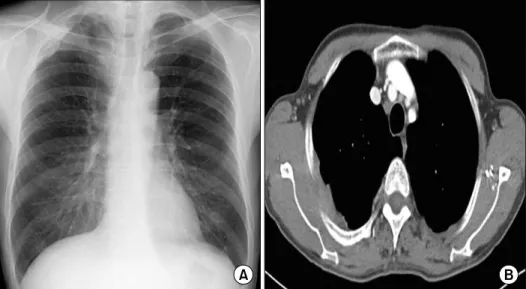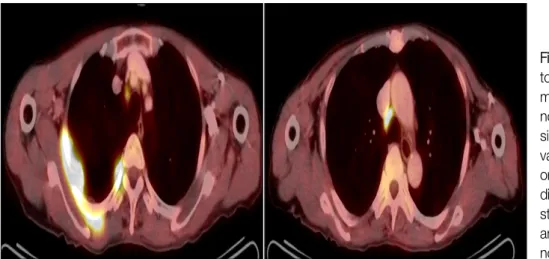222
http://dx.doi.org/10.4046/trd.2013.74.5.222 ISSN: 1738-3536(Print)/2005-6184(Online) Tuberc Respir Dis 2013;74:222-225
CopyrightⒸ2013. The Korean Academy of Tuberculosis and Respiratory Diseases. All rights reserved.
Primary Malignant Fibrous Histiocytoma of the Pleura
Kyung-Hwa Cho, M.D.1, Chul Park, M.D.1, Ki-Eun Hwang, M.D.1, Yu-Ri Hwang, M.D.1, Chang-Hwan Seol, M.D.1, Keum-Ha Choi, M.D.2, Mi-Kyung Lee, M.D.3, Soon-Ho Choi, M.D.3, Hak-Ryul Kim, M.D.1, Eun-Taik Jeong, M.D.1
Departments of 1Internal Medicine, 2Pathology, and 3Cardiothoracic Surgery, Wonkwang University School of Medicine, Iksan, Korea
Malignant fibrous histiocytoma, a type of sarcoma, is a malignant neoplasm with uncertain origin that arises in both the soft tissues and the bone. The occurrence of primary malignant fibrous histiocytoma of the pleura is extremely rare. We report a case of a 65-year-old Korean man who is being diagnosed with primary malignant fibrous histiocytoma of the pleura.
Key Words: Histiocytoma, Malignant Fibrous; Pleura; Surgery
Address for correspondence: Eun-Taik Jeong, M.D.
Department of Internal Medicine, Wonkwang University School of Medicine, 460 Iksan-daero, Iksan 570-749, Korea Phone: 82-63-859-2581, Fax: 82-63-855-2025
E-mail: jetpul@wonkwang.ac.kr Received: Jun. 21, 2012
Revised: Jul. 10, 2012 Accepted: Sep. 25, 2012
CCIt is identical to the Creative Commons Attribution Non-Commercial License (http://creativecommons.org/licenses/by-nc/3.0/).
Introduction
Malignant fibrous histiocytoma (MFH) of the pleura is extremely rare
1. The first case was reported in 1982
2. MFH is a soft tissue sarcoma mainly occuring in the soft tissues, especially in the extremities and trunk. MFH is an aggressive malignancy with high potential of local recurrence and distant metastasis
3-5. Surgery is treatment of choice even with recurrence and metastasis
6. In this report, we present the case of a 65-year-old Korean man who was diagnosed with primary MFH of the pleura.
We present the case and literature review about this un- usual MFH.
Case Report
A 63-year-old man presented with dry cough of a 2-week duration. He had a history of pulmonary tuber-
culosis that had been treated with anti-tuberculosis med- ication 10 years ago. He was a farmer and former smok- er, with 30 pack-years. Physical examination at the time of admission did not indicate any abnormality in the patient. Chest radiograph showed thickening in the right side of the apical pleura (Figure 1A). Chest com- puted tomography (CT) scans showed diffuse pleural thickening and a mass-like lesion with heterogenous en- hancement (Figure 1B). Trans-thoracic needle biopsy was performed to rule out malignancy. Histopathologi- cal examination of the biopsy specimen showed ana- plastic cytomorphology, with marked nuclear pleo- morphism and atypical mitoses. Immunohistochemistry staining was performed. The panel of monoclonal anti- bodies consisted of CD68, vimentin, calretinin, cytoker- atin 5/6 (CK 5/6), CK 7, thyroid transcription factor-1 (TTF-1), CD56, leukocyte common antigen (LCA), CD34, human melanoma black 45, and S-100. The tu- mor cells were positive for vimentin and CD68 (Figure 2). These cells were immunonegative for all other mark- ers tested, ruling out carcinoma (cytokeratin), sarcoma- tous mesothelioma (calretinin), solitary fibrous tumor (CD34), and neurogenic sarcoma (S-100 protein).
Brain magnetic resonance imaging and bone scan performed for cancer staging showed normal findings.
Positron emission tomography-computed tomography
Case ReportTuberculosis and Respiratory Diseases Vol. 74. No. 5, May 2013
223 Figure 1. Chest radiograph (A) and chest computed tomography (B) showed diffuse pleural thickening.
Figure 2. Histopathological examination of the biopsy specimen showed anaplastic cytomorphology, with marked nuclear pleomorphism and atypical mitoses (A, H&E stain, ×100). These tumor cells stained positively for vimentin (B, ×400) and CD68 (C, ×400).
(PET-CT) showed multinodular hypermetabolic lesion (standardized uptake value, 13.2) at the posterior pleu- ral aspect, with mediastinal lymph node metastasis in the right upper and lower paratracheal nodes (Figure 3). Thus, the final diagnosis was mesenchymal malig- nancy, primary MFH of the pleura without metastasis beyond the thorax.
The patient underwent thoracotomy with excision of the bulk of the primary mass. The pleural masses on apico-posterior mediastinum which was encountered with third costoverbral joint was resected. Resection of the upper lobe attached to the primary mass, intercostal muscle, right second, third and fourth ribs and media-
tinal lymph node dissection was done. The post-oper- ative biopsy result was the same type of the MFH (pleomorphic type) as that of the trans-thoracic needle biopsy performed before the operation. Cancer in- vasions in lung, ribs, intercostal muscle, vertebra were noted. The patient was discharged after his condition improved but had been lost to follow up since discharge.
Discussion
MFH is the most common soft-tissue sarcomas in
adults. MFH occurs most commonly in the extremities
KH Cho et al: Primary malignant fibrous histiocytoma of the pleura
224
Figure 3. Positron emission tomography-computed to- mography showed multi- nodular hypermetabolic le- sion (standardized uptake value, 13.2) at the posteri- or pleural aspect, with me- diastinal lymph node meta- stasis in the upper right and lower paratracheal nodes.
(70–75%), followed by the trunk and retroperitoneum.
MFH is characterized by a bimorphic population of fi- brocytes and histiocytes usually arranged in a storiform pattern
7,8.
Primary pleural MFH is extremely rare
9,10. Only one case have been reported in the literature of Korea so far
1. There are no typical clinical symptoms, but the pa- tients with pleural MFH usually experience chest pain, cough, and hemoptysis. Their chest radiographs and chest CT usually show diffuse masses of the visceral and parietal pleura. Chest CT is not specific for MFH. There are no suggestive imaging patterns that can be used for the diagnosis prior to biopsy. The exact diagnosis of pleural MFH depends on an accurate differential diag- nosis from other malignancy by results of the histo- pathology and immunohistochemistry. Therefore, the use of an antibody panel is recommended in order to confirm the diagnosis of pleural MFH and to rule out a commonly considered differential diagnosis. Immuno- histochemically, MFH are nearly uniformly positive for vimentin, CD68 and negative for calretinin, cytokeratin, TTF-1, CD56, LCA, CD34, and S-100 protein. The identi- fy of CD68 and vimentin, mesenchymal differentiation marker and absence of normal lung tissue in primary mass suggests that MFH is originated in pleura
11,12. MFH has been categorized into five types, based on the histopathologic subtype, including storiform-pleo- morphic, myxoid, inflammatory, giant cell, and angio- matoid variants. Since primary pleural MFH is very rare-
ly reported, if it has been diagnosed histopathologically, a comprehensive evaluation should be immediately per- formed to check whether it is a metastatic tumor origi- nating from the lower extremities and abdomen or a pri- mary tumor. The lung, ribs, intercostal muscle, vertebra were possibility of primary focus because postoperative biopsy result revealed cancer invasions in theses structures. However, the lesion in this case report is pri- mary pleural MFH because imaging modalities, includ- ing CT, bone scan, PET-CT revealed no tumors other than the pleural tumor and postoperative pathologic finding suggested cancer invasion of their surrounding soft tissue in addition to bone marrow of rib, vertebra.
Surgery is the cornerstone of treatment for all soft-tis- sue sarcomas
13. The goal of surgery is to eradicate the disease from the affected area. The effect of either che- motherapy or radiotherapy is presently unclear. The prognosis of MFH depend on complete surgical re- section with negative microscopic margins, associated to improved disease free specific survival. Prognostic fac- tors that are known to correlate with survival in patients with MFH include tumor grade, depth, size, metastatic status, patient's age, and histologic subtype
14. Favorable prognostic factors include age less than 60 years old, tumor size less than 5 cm, superficial location, low grade, the absence of metastatic disease, and a myxoid subtype.
In conclusion, primary pleural MFH is extremely rare
tumor and its diagnosis is confirmed by the histopathol-
Tuberculosis and Respiratory Diseases Vol. 74. No. 5, May 2013

